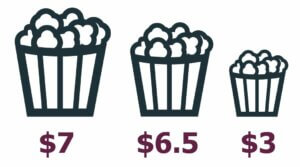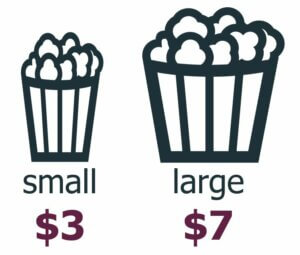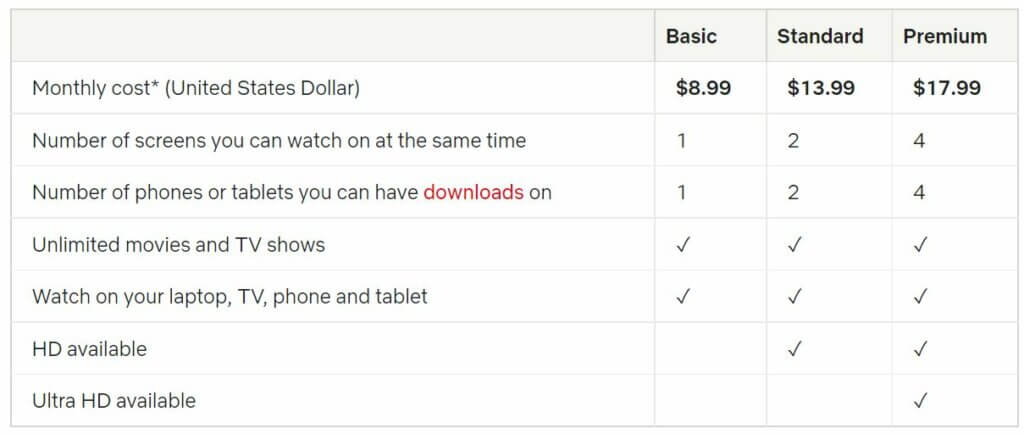Learn how to price your products and services with psychological tricks– Anchoring and The Decoy Effect.
When it comes to economics, buyers and sellers are generally assumed to always act in their own interests. But this is not how we behave in real life.
Behavioural economics takes into account the irrational human being, resulting in new pricing strategies that influence what and when we buy. Pricing for products and services is easier when you understand Anchoring and The Decoy Effect.
Let’s examine them using a couple of real-life examples.
Anchoring in product pricing
Watch this video of Steve Jobs announcing the price of the iPad on stage in 2010:
“What should we price it at?” asks Jobs.
Jobs adds: “Well if you listen to the pundits, we’re going to price it at under US$1,000 – that is, US$999.”
“US$999” appears on the big screen.
On the screen, the price of US$999 goes out of the picture and US$499 appears as soon as Jobs says, “I’m thrilled to announce to you that the iPad pricing starts not at US$999, but at $499. At US$499, a lot of people can afford an iPad.”
Jobs was a true showman, always quick with mental triggers. What catches our attention in this example is the price anchoring. By placing the number US$999 in the audience’s mind, he makes US$499 look like a bargain. The proof of this is that Apple sold 300,000 iPads on the first day.
Anchoring may be one of the simplest and most powerful tactics you can use in your pricing.
One way to do this, using Jobs’ US$999 tactic, is to talk about the real value your product will deliver. If your human resources management software can help your client save US$200,000 in recruiting costs, use that as your price anchor.
When you reveal the price of US$50,000, he will realise what a great deal you’re offering. Without the anchor, the US$50,000 may seem like a high price.
The Decoy Effect: How a bag of popcorn can explain the way we make decisions
The “decoy effect” is a technique identified by Dan Ariely in his book Predictably Irrational (2008). In short, it’s about using the human need to make comparisons in order to make supposedly rational and correct decisions. It allows us, in effect, to hack our customers’ brains, influence their decisions to a certain extent, and direct them to the best path.
Don’t think that’s possible?
Let’s do a quick experiment. You go the cinema to watch your favourite actor’s movie. The tempting thought of popcorn laced with salt and butter compels you to buy popcorn. Upon arriving at the food kiosk, you’re faced with the following products:

What size would you choose?
I bet you ended up choosing the bigger one. After all, for just extra US$0.50 you get a lot more popcorn, right?
What if you only had the options below?

In this scenario, possibly, you might have chosen the smaller size – depending on how hungry you were – since there’s no longer the medium-size decoy, which reinforced the benefits of buying the largest size in the previous scenario.
This same experiment was carried out several times and with different products and services. The decoy effect always elicited this same behaviour and generated greater financial gain.
Usually, this effect is created by linking three elements, with one of them playing the role of decoy, which reinforces some important attributes of the purchase and influences the buyer’s decision.
Let’s take another example. Suppose you’re looking for a place to take a vacation and your travel agent recommends two destinations, Rome and Paris. Both trips include airfare, hotel, tours, and breakfast in the package. Which will you choose?
Difficult, isn’t it? To make this decision, you’d need a lot of time, as both places have their advantages and disadvantages. But what if we add a third option, called (Rome) which doesn’t include free breakfast? It would look like this:
– Package 1: Rome: Tickets, hotel, tours, and breakfast included
– Package 2: Paris: Tickets, hotel, tours, and breakfast included
– Package 3: (Rome): Tickets, hotels, and tours included in the package. Breakfast will be paid separately.
Notice that the comparison with the last option (Rome) makes the package to Rome with the free breakfast look even better. In fact, it makes it look even better than the option for Paris, which has no other comparative option.
How does this happen in digital environments?
If you have a Netflix subscription, your plan is likely to be either Standard or Premium. And now you know why. The “uglier” plan basic is just a decoy to make you spend more.

source: netflix.com
How can we use this cognitive bias?
If you want to use a decoy price to help guide customers to buy your best products, consider offering different options or packages that add an anchoring effect and highlight the value of the option you really want to sell.
On the other hand, customers will find this useful because they can make comparisons and feel that they’re making the right choice by choosing the best-value-for-money option. This is why you need to create internal competition among your products.
Now that you know more about product and service pricing, it’s time to apply it to your business and start growing again.
This article first appeared on e27.co

